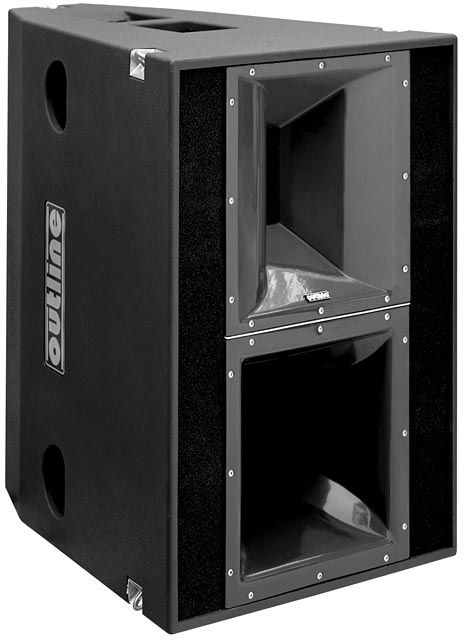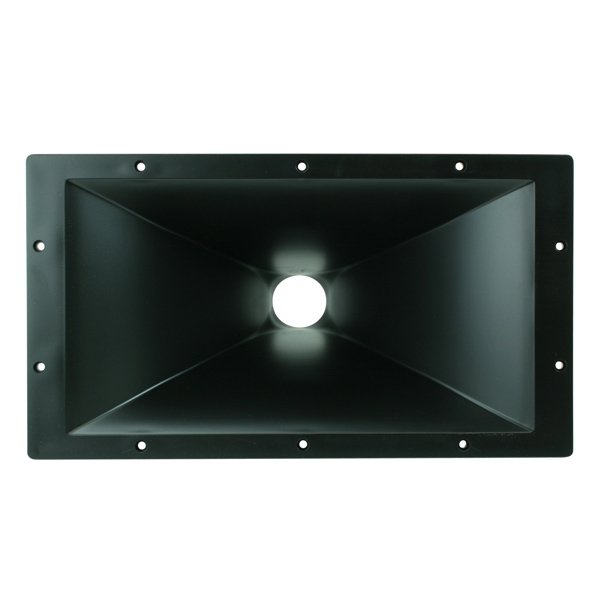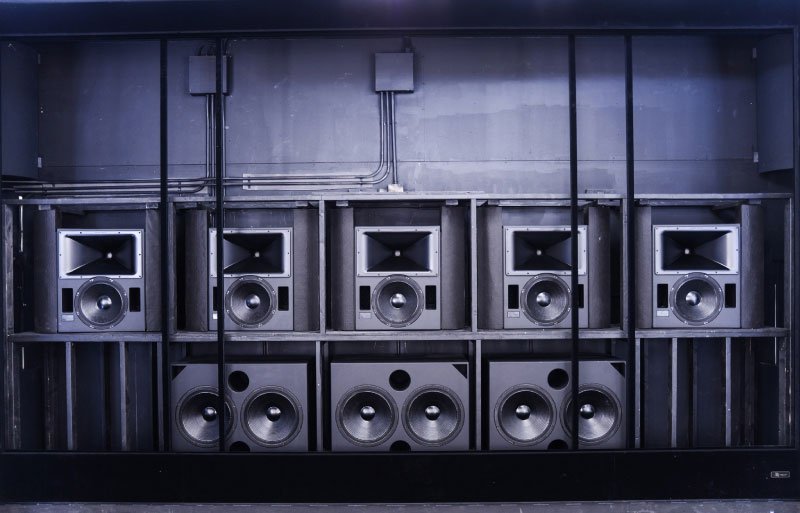
ARX
-
Posts
102 -
Joined
-
Last visited
Content Type
Forums
Events
Gallery
Posts posted by ARX
-
-
-
-
Such (past) practices and habits also contributed to the bad reputation of horn-loaded speakers in general, not to mention the poisoning of visitors from the magical smoke released when yet another TAD Beryllium diaphragm gave up 😵
-
This is an Original Klipsch OEM DE75-8P. The "P" refers to Plastic phaseplug. Mine have metal phaseplugs.

Newer, or upgraded doesn't always mean better, especially with companies driven by cost efficiency.
B&C introduced TN diaphragms to comply with PA requirements. The (glue of the) original Mylar surrounds tended to melt due to the heat generated inside the gap at sustained high SPL.
Depending on the horn used, the FaitalPro Titanium drivers can be crossed around 600Hz, possibly even lower with steep slopes. The B&C drivers with Mylar suspended diaphragms are best crossed >700Hz.
Salient detail: Danley exchanged FaitalPro drivers for B&C DE880s in the SH96 (non-HO version), apparently because of a high failure rate.
-
A highly regarded Dutch PA company called Duran Audio - now part of Harman International - developed some loudspeaker systems using the DE75.
25 years after the introduction, quite a few of these systems are still in use today. Especially the mid-high section is praised for its high fidelity.
The system shown below was removed from the Johan Cruijff ArenA in Amsterdam.
-
The original DE75 is still a very nice driver, even though it was first introduced in the 1990's. It's a legendary and game-changing B&C product as well, because its "hi-fi sound" was appreciated by big PA companies like EAW, NEXO and Martin Audio. This is a short and interesting interview with B&C's CEO Lorenzo Coppini in which the DE75 is explicitly mentioned.
Personally, I prefer the sound of the DE75 to many later B&C drivers with pure Titanium diaphragm (drivers with the suffix -TN) .
Here's a measurement of the DE75 with B&C's ME60 horn (I bought my DE75s for €100 with these horns attached).
There's the usual breakup starting just below 10 kHz, but the resonances are pretty well dampened, as is visible in the waterfall plot.
For comparison B&C's recent DE95TN attached to the same ME60 horn:
-
-
Tractrix or not, with a depth of only 127mm it's next to impossible to properly load the driver down to 500Hz. At best it manages 800Hz, but 1000Hz seems more plausible. The mumbs in the current K510 increase the pathlength (and resistance) and thus provide better loading.
I expect the ZXPC 18 X 10 to beat this K510 clone wrt loading and polar response. Last but not least, the throat transition of the 18 X 10 looks a lot better (sometimes a little sanding is required to smooth out imperfections).
I am looking forward to Chris' measurements though.
-
Yes, but the (4) buttocks of the M2 WG serve a slightly different purpose, namely wide dispersion.
It's basically a reinterpretation of the old 2344.
The mumps in the K510 improve pattern control as well as loading of the driver.
The M2 waveguide doesn't load the driver well, because it's very shallow:
If you want to manipulate the wavefront in a similar way, but at higher frequencies, you'll end up with something like this:

-
1 hour ago, moray james said:
interesting looking loudspeaker could you provide a link or additional information? thanks.
Sure, here's a link to the later version of this product line.
Don't forget to check their loudspeaker processing technology, called NEWTON, which is undoubtedly the most advanced on the market.
So far, it's only available for MacOS.
This is an earlier version of the same horn top, which is loaded with B&C drivers:
-
 1
1
-
-
-
On 5/27/2019 at 2:05 PM, jjptkd said:
Nice build! Just curious about your choice on the Faital Pro driver have you compared these to the B&C drivers like what Klipsch uses? I'm thinking about building a 2-way like this using a Chorus 1 cabinet and woofer kind of like your smaller CornScala what I was hoping to do was make it more like the KI-396 with the k-510 horn and k-691 driver or from what I've read the B&C-75 driver is the same. The B&C drivers have a 2" exit compared to the 1.4" exit on the Faital Pro driver I wonder how much of a difference that makes? Any input would be appreciated thanks!
I own the DE-75s as well, but you cannot use these with LTH142, because the throat is too small.
You could use a JBL 1.5 exit driver with some sanding of the horn throat > use a drill press with a tapered plug wrapped in fine grid sandpaper.
For those interested: This is a clone of the LTH142 for a fraction of the price.
The LTH142 is not a constant directivity horn, but it's less 'beamy' compared to a round Tractrix.
-
 1
1
-
-
In this thread some topics were touched on, that may not be clear and obvious to everybody.
This easy to understand AES paper deals with some important issues related to horns, waveguides and drivers.
-
19 hours ago, Chris A said:
I've been waiting for someone to start discussing the throat entries of the K-510 and K-402--because they're not oblate spheroid--but their performance is near perfect. This is especially true for the little K-510 horn, which outperforms what it should be able to do on the low end by quite a bit compared to other typical horns.
There's a whole crowd over at diyAudio that religiously believe that OS throats is the best thing since sliced bread. I disagree, and the data and subjective listening trials on these two Klipsch-designed horns more than support that disagreement. I don't believe that many people are really looking at this area very closely.
I came to the same conclusion through different reasoning and sources, as I don't have first hand experience with K510 or K402.OS disciples are plentiful....that is: among the DIY crowd.
To my knowledge OS waveguides were used in only a few professional products from the 1990's. It's rather old news by now.
With the advent of advanced modeling and simulation techniques, only fundamental theories remain functional.
This is not to dismiss OS waveguides completely, but to put things in perspective.
-
3 hours ago, Chris A said:
That Meyer drawing of its K-510-like horn looks like they've pushed the point of the mouth roll-out closer to the mouth than the K-510's tractrix roll-out, which starts about two-thirds of the way from the horn throat.
Other than that, it looks like a K-510 clone with a smooth throat radius (which is a mistake from the standpoint of retaining the highest frequency beamwidth, I've found). The K-510 and K-402 use straight-sided walls all the way to the throat after the tractrix roll-out tangent point is reached--looking toward the throat (as it is with tractrix curves). This is a pretty important little issue...
That's an interesting observation on the throat.
I've looked closely at images of the K510 MK1 & 2 as well as the K402. Specifically the throat area, because it's this part of any horn that affects the aforementioned higher frequencies.
It appears there's (possibly) a very clever solution incorporated in the Klipsch throats.
This is the throat area of the K510 with mumps:
What can be seen in this image?
This clearly isn't the typical round to rectangular (duct) transition as present in the ZXPC horns.
The left and right side of the throat comprise a kind of slot, before the mumped section.
Even more interesting are the corners of the throat entrance, which are identical in the K402 (but correct me if I am wrong).
"Segmented triangles" are visible, which may (or may not) function as a kind of mini-waveguide inside the actual horn.
-
 1
1
-
-
Chris, agreed with all your points.
One little caveat with regards to my observations of the BlueHorn. With "high frequencies" I meant the upper midrange (2 to 4 kHz) and above.
-
I like the zebrawood.
What driver do you use with the ZXPC horn?
Is the horn used as center?
-
Back on topic, more or less.
A comparison between a MeyerSound Archeron horn (> predecessor of the BlueHorn) and the ZXPC 10x18.
Thanks to @Chris A for the data on the ZXPC horn.
CAD Drawing of the MeyerSound Archeron:
Low frequency driver: 15 inch cone driver
Enclosure dimensions:width (w) = 31 inches
height (h) = 35 inches
depth (h) = 21 inches
Horn locating dimensions:x = 15.5 inches
y = 9.38 inches
Horn axis to driver center spacing: s = 14.37 inchesThe Waveguide:
Horizontal:
Vertical:
Improved vertical beamwidth which includes a signal processing circuit including cross-over circuit portions, and demonstrating extended beamwidth control from 500 to 800 Hz:
ZXPC 10x18 Inch Drawing:
Horizontal:
Vertical:
-
10 hours ago, dwilawyer said:
Have you heard his stuff? I have, in a lot of different set ups. It like a lot of stuff, set up, etc
The main complaint I see is using their speakers to mix sometimes doesn't "translate" to the reality of what some older systems can handle. A lot of debate about that.
His Galieo system is what they have in The Stag, and that is a marketing model that for sure keeps you loyal, LOL.
I am familiar with (the sound) of older MeyerSound stuff, mainly their line arrays, and some of their cinema speakers. In the past I had some conversations with the local distributor.
Meyersound line array products face fierce competition from brands such as: l'Acoustics, Adamson and not in the least d&b Audiotechnik.
Based on (listening) experience, I would personally choose l'Acoustics and d&b over MeyerSound as far as line arrays are concerned, but that's not to say MeyerSound is bad. Not at all.
MeyerSound PA has been referred to as clinical and sometimes harsh sounding, which should come as no surprise once you dive deeper into their technology and considering their background in studio monitoring/mastering.
In PA, the cleanest, most linear, FIR compensated or otherwise pre-processed signal doesn't always translate to the best (most enjoyable) front-end experience, especially with less talented people behind the desk.
Cinema installs are less prone to cluttering, which should work to MeyerSound's advantage.
-
13 hours ago, Khornukopia said:
I would be happy to try and compare those Blue horns to my good sounding cheap eBay horns, but the top left corner of the Blue one looks really expensive.
I bet it is expensive, and of high quality.
Obviously, MeyerSound horns are at least a little better than a white label horn.
Presumably BEM/FEM optimized for the dedicated driver and comparable to the waveguide in JBL's 4367.
Upon examination some features stand out.
Its depth relative to expansion (curvature). From a wide angle the throat is still visible. This should ensure even off-axis radiation of high frequencies.
The vertical walls are asymmetrical > the "ceiling" is more curved towards the mouth. The bottom section is relatively flat, probably to facilitate better integration with the woofer. For the same reason C-C spacing is minimized.
It's noteworthy both horn and woofer of the monitor are surface-mounted, whereas the subwoofer sits flush with the baffle.
@Khornukopia What's that beautiful veneer?
-
-
Lucas and Meyers' relationship goes way back indeed and it's logical to support each other('s business). Nothing wrong with that.
Key factor in Meyersound R&D is its integrated design approach. Subsequently, it's not sensible and often nearly impossible to use their products outside of their ecosystem.
With the older products, especially the 650-P Subs you mentioned, it was less problematic to use these seperately.
From a premium brand with corresponding pricing you'd expect top-notch performance and Meyersound delivers... most of the time.
However, after reading the marketing blah-blah on their latest BlueHorn System and looking at the horn in question, I wonder what kind of voodoo takes place in that black hole between the driver exit and the horn entrance.
It's should give rise to performance levels way beyond anything this cheap ebay horn could ever deliver.

-
4 hours ago, dwilawyer said:
Yes, for the 5 across the front, the original subs were all Meyer, I can't remember what they had for surrounds. When I got a chance for a second look more recently('14?), all of the TAD was taken out and it it is all Meyer now.
I wonder if this decision was marketing related, induced by technological progress, or both.
Meyersound delivers turn key products with SOTA active amplification + DSP.
However, I doubt the raw drivers will better the TADs.The Archeron horns from the EXP series are nice, but way too small for large theatres.
In reference to what @Chief bonehead said about the requirement of active crossovers for the K402's, the same goes for the Meyersound Archerons.
So they either use the side channels for infill, custom large format horns or line arrays.
-
Probably something like this:

And for mains:



























.thumb.jpg.aab2b58ee530b1c071dfaf613c34fad0.jpg)





Double Stack ESS AMT-1 with Wings--Possible Kit for Heritage
in Technical/Restorations
Posted
There's a lot of useful information in this thread.
To be honest, I've never really cared much for AMTs, but I've always had a weak spot for the big Heils, of which I own a pair. Unfortunately, the diaphragms didn't survive years of abuse in a cafe.
IMO the horn loaded twin/stacked ESS AMTs beg to be used in combination with a Bert Doppenberg's Orelo-style horn loaded OB. The crossover point (560 - 600Hz) isn't ideal for multiple 15s, but should be low enough for 4, or 6x 10 or 12".
Straight wings with a curved end flare could be used so that the stacked Heils can be integrated.
Cheap 12" with Fs: 34 Hz and Qts: 0.59:
